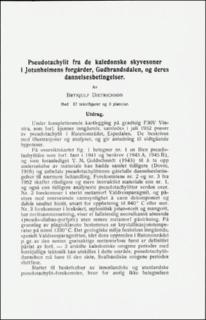| dc.contributor.author | Dietrichson, Brynjulf | |
| dc.date.accessioned | 2020-08-26T12:42:31Z | |
| dc.date.available | 2020-08-26T12:42:31Z | |
| dc.date.issued | 1953 | |
| dc.identifier.uri | https://hdl.handle.net/11250/2674607 | |
| dc.description.abstract | The old tourists thought of the district as an anterior court to the Jotunheim mountainrange, and this designation also applies in a geological sense. We here find exposed the basement parts in front of the heavy thrust- masses which advanced from the NW during the 3rd of the 3 distinct periods of Caledonian orogeny pointed out in our district and probably corresponding to: 1. The Trondheim orogeny, 2. The Ekne orogeny, 3. The Svalbard orogeny (Th. Vogt 1928). The second period is characterized by succsessive folding, overfolding and imbrication advancing from NE(SSW) with axes NW(WNW) to SE (ESE), particulary distinct impressed in the topography of our district as appears from the map fig. 1. The pseudotachylites and the supposition for their genesis are considered by prominent geologists in this country and abroad (Goldschmidt and Holmes) as most puzzeling. | |
| dc.language.iso | nor | |
| dc.relation.ispartofseries | NGU (184) | |
| dc.rights | Navngivelse 4.0 Internasjonal | |
| dc.rights.uri | http://creativecommons.org/licenses/by/4.0/deed.no | |
| dc.subject | PETROGRAFI | |
| dc.subject | STØRKNINGSBERGART | |
| dc.subject | OMDANNET BERGART | |
| dc.subject | SEDIMENTÆR BERGART | |
| dc.subject | ANORTOSITT | |
| dc.subject | GRANITT | |
| dc.title | Pseudotachylit fra de kaledonske skyvesoner i Jotunheimens forgårder, Gudbrandsdalen, og deres dannelsesbetingelser | |
| dc.type | Journal article | |
| dc.description.localcode | 35542 | |
| dc.source.pagenumber | 23-70 + p | |

